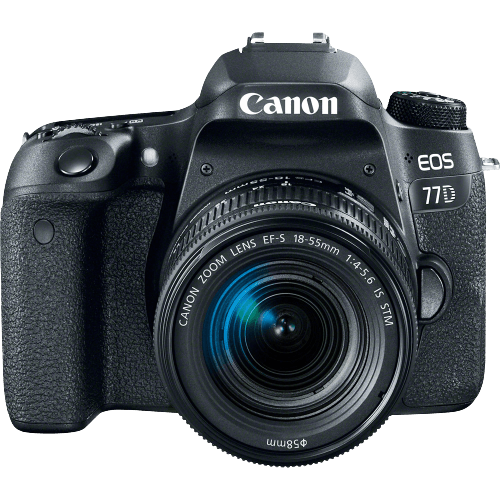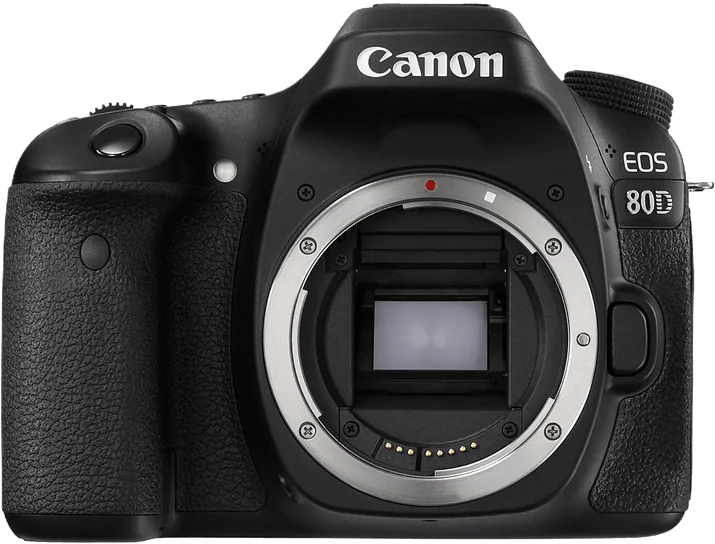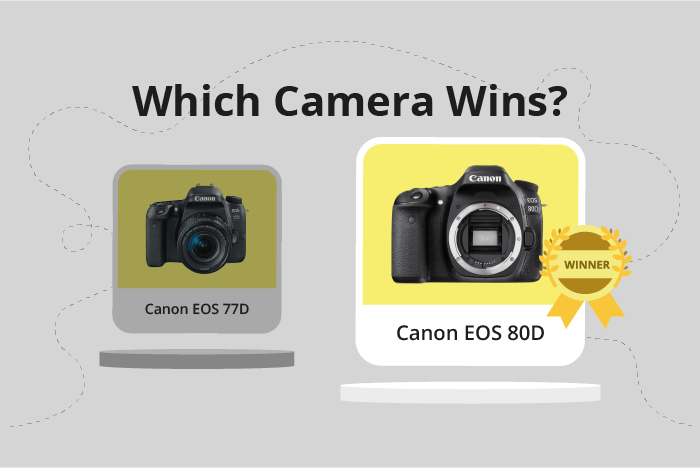Canon EOS 77D vs EOS 80D Comparison
Canon EOS 77D

Canon EOS 80D

The Canon EOS 80D edges out the Canon EOS 77D with a score of 64/100 compared to 63/100. Both cameras are DSLR models, released in 2016 and 2017, respectively. They share similar specifications, such as camera type and launch prices of $1200 for the 80D and $900 for the 77D.
The EOS 80D is superior due to its slightly smaller size (139 x 105 x 79mm) and lighter weight (730g / 1.61lbs), making it more portable and convenient for photographers. On the other hand, the EOS 77D has the advantage of being more affordable, with a $300 lower launch price than the EOS 80D.
Considering these factors, the Canon EOS 80D is the better option for those who prioritize portability, while the Canon EOS 77D is ideal for budget-conscious photographers.
Canon EOS 77D vs EOS 80D Overview and Optics
The Canon EOS 77D narrowly wins in the optics comparison with a score of 64/100, while the Canon EOS 80D scores slightly lower at 63/100. Both cameras share several specifications, including 24.2 megapixels, a CMOS sensor type, an APS-C sensor size, a Canon EF-S lens mount, and lack of image stabilization.
The Canon EOS 77D has a Digic 7 processor, which is an improvement over the Digic 6 processor found in the Canon EOS 80D. This newer processor provides the 77D with a faster and more efficient performance, making it a better choice for those who prioritize processing power in their cameras.
On the other hand, the Canon EOS 80D has a shooting speed of 7 frames per second, which is one frame faster than the 77D’s 6 frames per second. This advantage allows the 80D to capture fast-moving subjects more effectively. Additionally, the 80D has a slightly higher DXOMARK score for its sensor at 79, compared to the 77D’s score of 78. This difference suggests that the 80D might produce slightly better image quality in certain situations.
While both cameras have their strengths, the Canon EOS 77D’s superior processing power gives it a slight edge in the optics comparison. However, the Canon EOS 80D’s faster shooting speed and marginally better sensor score make it a solid choice for those who prioritize capturing fast-moving subjects. Ultimately, the decision between these two cameras will depend on the specific needs and preferences of the user.
Canon EOS 77D vs EOS 80D Video Performance
The Canon EOS 77D and Canon EOS 80D both have a video score of 70/100, showing that there is no clear winner in terms of video capabilities. These cameras share common specifications in video performance, making them ideal choices for those looking to capture high-quality videos.
Both the EOS 77D and EOS 80D offer Full HD video resolution, with maximum video dimensions of 1920 x 1080. This ensures that users can record sharp and clear videos with both cameras. Additionally, they have a maximum video frame rate of 60fps, allowing for smooth motion capture during video recording. Another shared feature is the built-in time-lapse functionality, which enables users to create stunning time-lapse videos with ease.
While there is no clear winner in terms of video capabilities, it is essential to consider other factors that may influence your decision. For example, the EOS 80D has a more durable build and weather sealing, making it a better choice for those who frequently shoot outdoors or in challenging conditions. On the other hand, the EOS 77D is lighter and more compact, which may be more appealing for those who prioritize portability and ease of use.
As both cameras have the same video score and specifications, the decision ultimately comes down to personal preferences and other factors, such as build quality and size. Both the Canon EOS 77D and EOS 80D are capable of delivering high-quality videos, making them suitable options for users looking to capture stunning visuals.
Canon EOS 77D vs EOS 80D Features and Benefits
The Canon EOS 77D and Canon EOS 80D both have a feature score of 70/100, indicating that they share many similar specifications. In terms of common features, both cameras have a 3-inch screen size, a screen resolution of 1,040,000 dots, a touchscreen, a flip screen, WIFI connectivity, and no GPS.
The Canon EOS 77D has an advantage over the Canon EOS 80D in terms of Bluetooth connectivity, as the 77D includes this feature while the 80D does not. This allows for easier and more convenient wireless connections between the camera and compatible devices, such as smartphones and tablets.
On the other hand, the Canon EOS 80D does not have any significant advantages over the Canon EOS 77D in terms of features. Both cameras have the same feature score, and the specifications listed above show that they are quite similar in their offerings.
Considering the similarities between the Canon EOS 77D and Canon EOS 80D, it can be concluded that both cameras offer comparable features and cater to the needs of many photographers. The main difference between the two is the Bluetooth connectivity offered by the Canon EOS 77D. This feature may or may not be important to individual users, so photographers should evaluate their specific needs when deciding between these two cameras.
Canon EOS 77D vs EOS 80D Storage and Battery
The Canon EOS 80D outperforms the EOS 77D in storage and battery, scoring 43/100 compared to the 77D’s 29/100. Both cameras share common specifications, including a single memory card slot and compatibility with SD, SDHC, and SDXC (UHS-I) memory cards. Neither camera supports USB charging.
The EOS 80D’s superior battery life sets it apart, offering 960 shots per charge compared to the 77D’s 600 shots. This advantage comes from the EOS 80D using the LP-E6N battery type, while the EOS 77D utilizes the LP-E17 battery.
Although the EOS 77D falls short in battery life, it does not have any unique advantages in storage and battery over the EOS 80D. Therefore, the EOS 80D remains the better choice for users prioritizing longer battery life and more shots per charge.
Alternatives to the Canon EOS 77D and EOS 80D
Are you still undecided about which camera is right for you? Have a look at these popular comparisons that feature the Canon EOS 77D or the Canon EOS 80D:

